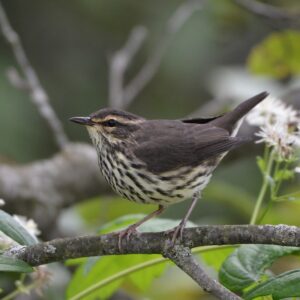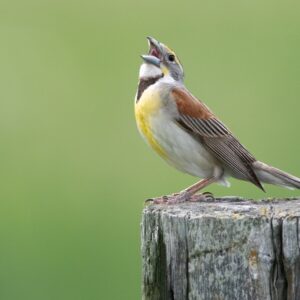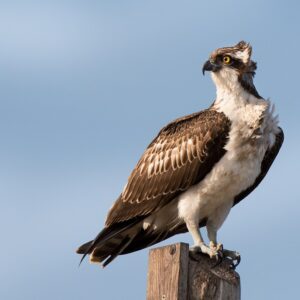Banding Chickadees at the Lac Deschênes Naturehood Tour
[two_third]On a crisp and cool Saturday morning, I joined Ted Cheskey, Nature Canada’s bird conservation manager, and two volunteers from the Outaouais Birding Club on the banks of the Ottawa River to band birds. As part of the Lac Deschênes Naturehood Tour, a multi-stop bird watching tour in Ottawa-Gatineau’s very own Important Bird Area, Ted was leading a bird banding demonstration at the Houle Street Boat Launch on the Gatineau side of the river.
Ted had set-up mist nets close to the river’s edge with the hope of catching small songbirds. Within an hour, four Black-capped Chickadees and one American Goldfinch had flown into the nets. The birds were very gently removed from the nets, placed in cloth bags and brought back to the Nature Canada tent where they could be weighed and banded.
After a bird has been inspected, it’s released where it was caught. I had the pleasure of releasing a bird under Ted’s guidance. Ted showed me a ‘banders’ grip’, then placed a Black-capped Chickadee in my hand. I slowly uncurled my fingers, opening my palm to the sky. But the little guy wouldn’t let go! It clung on to my index finger, hanging upside down even as I fully extended my fingers outwards. Then in a flash, it was gone. It was a very cool experience!
What should you do if you find a banded bird?
Bird banders occasionally capture birds banded by another bander. Non-banders can also come across banded birds, but this often happens under unfortunate circumstances. As a non-bander, you’re likely to find a banded bird that has died from striking a window (one of the most common human-causes of death in songbirds), a vehicle, or one that has been killed by a cat. If you find a banded bird, you can report your finding by phone, on the web or via mail.
Here are three ways you can submit your findings:
Phone :1-800-327-BAND (2263)
Web: http://www.pwrc.usgs.gov/BBL/bblretrv/
Mail: Write down some basic facts, put the band in an envelope, and send it to “AVISE BIRD BAND, WASHINGTON DC, USA.” The most important facts to report are the number on the band – and it is a long one, make sure you report it accurately – the date and location where you found it; the apparent cause of death, if you found a dead bird; your contact information. Don’t worry about trying to identify the bird, as the band contains that information. The banding office will send you a certificate of appreciation in return for your effort, letting you know what type of bird it was, and where and when it was banded. This information goes into a database that is shared between Canada and the USA and is accessible to the public and scientists.
The Lac Deschênes Naturehood Tour was coordinated by Nature Canada, the Ottawa Field-Naturalists’ Club and the Club des Ornithologues de l’Outaouais. It used the same concept as a studio or winery tour to better acquaint local citizens with the globally significant Lac Deschênes Important Bird Area (IBA) that’s found right in the heart of the National Capital Region.
Birding experts from both naturalist clubs and Nature Canada were stationed at each tour stop to help visitors explore the natural wonders of one of this region’s best areas for birding.
The event was part of a larger project, My Naturehood, which focuses on celebrating birds, raising public awareness about birds and other wildlife, and protecting significant habitats in Lac Deschênes Important Bird Area.
Visitors to the Houle Street Boat Launch site included a junior birder (who was eager to discuss the State of Canada’s Birds with Ted), local nature-enthusiasts, birders from the Ottawa Field-Naturalists’ Club and the Outaouais Birding Club and a Chinese environmental lawyer who was visiting the city of Ottawa.
Over at Bate Island, another stop on the Lac Deschênes Naturehood Tour, visitors were treated to the sighting of a rare bird for this area – a Cave Swallow.
It’s possible that this sighting could be linked to Hurricane Sandy fall-out from the flocks of Cave Swallows that have been noted moving up the Atlantic seaboard in the fall. Perhaps this particular Cave Swallow was pushed inland by Hurricane Sandy. The National Audubon Society’s description for the species explains that “Birdwatchers have increasingly noted late fall incursions northward along the Atlantic seacoast as far north as Nova Scotia and inland along Lake Champlain.”
We were lucky to spot such a rare sighting!
We’d like to extend a big thank-you to the volunteers from both the Ottawa Field-Naturalists’ Club and the Outaouais Birding Club for supporting the Naturehood Tour and to the funders of My Naturehood.
[/two_third] [one_third_last]
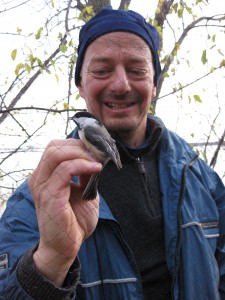 Ted Cheskey holds a Black-capped Chickadee
Ted Cheskey holds a Black-capped Chickadee
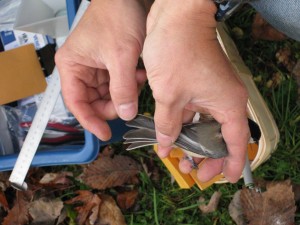 Ted holds a Black-capped Chickadee that has just been banded.
Ted holds a Black-capped Chickadee that has just been banded.
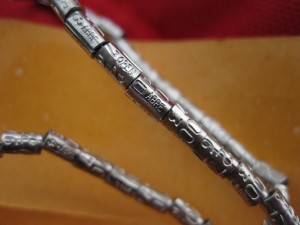 Close-up of a bird band.
Close-up of a bird band.
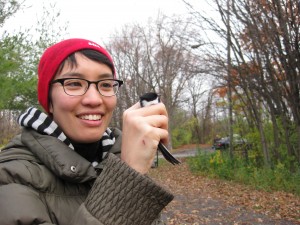 I’m ready to release a Black-capped Chickadee
I’m ready to release a Black-capped Chickadee
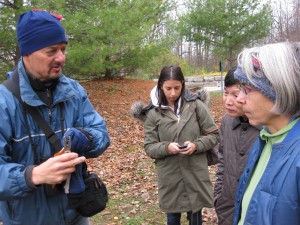 Ted explains the banding process to Naturehood Tour participants.
Ted explains the banding process to Naturehood Tour participants.
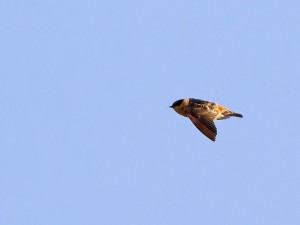 Cave swallow by nebirdsplus via Flickr
Cave swallow by nebirdsplus via Flickr
[/one_third_last]

